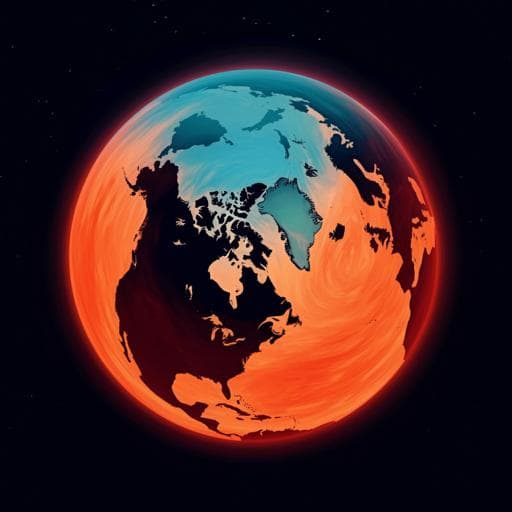
Earth Sciences
Manifold increase in the spatial extent of heatwaves in the terrestrial Arctic
M. Rantanen, M. Kämäräinen, et al.
Discover how the expanding spatial extent of heatwaves in the Arctic could impact ecosystems and societies. This groundbreaking research, conducted by Mika Rantanen, Matti Kämäräinen, Miska Luoto, and Juha Aalto, reveals alarming trends in heatwave severity over the decades, with projections indicating continued growth into the future.
~3 min • Beginner • English
Introduction
Heatwaves have become longer, more intense, and more frequent worldwide in recent decades, with strong evidence of human influence. The Arctic has also experienced increasing heatwave occurrence, exemplified by the 2020 Arctic heat record of 38.0 °C in Verkhoyansk, Siberia. Heatwaves can trigger ecosystem-level disturbances, including enhanced wildfire activity driven by warmer, drier summers and increased vegetation fuel loads. The Arctic’s extensive permafrost stores vast amounts of organic carbon; broader heatwave coverage can promote widespread thaw and release of CO2 and CH4, amplifying climate change. Early snowmelt and earlier vegetation greening, combined with summer heatwaves, can intensify heat through soil moisture depletion and vegetation browning. Heatwaves also pose significant public health risks, which may grow among Arctic communities as high-latitude warming accelerates. Traditional heatwave metrics include frequency, intensity and duration, but recent work suggests cumulative indices better capture total impacts by integrating duration and temperature anomaly. One widely used cumulative metric is the heatwave magnitude index daily (HWMId), a percentile-based index that aggregates excess temperatures above a normalized threshold and is particularly suitable for the Arctic’s diverse climates. Prior work found increasing HWMId trends in Arctic regions during 1979–2015. Building on higher-resolution ERA5-Land reanalysis (1950–2022) and CMIP6 models, this study examines both observed and projected changes in the spatial extent of heatwaves across the terrestrial Arctic. The main objective is to quantify observed (1950–2022) and projected (to 2099) changes in heatwave spatial coverage, providing insight into increasing exposure of Arctic ecosystems and societies to intensifying extreme heat.
Literature Review
Previous studies established that heatwaves are increasing globally in frequency, intensity, and duration, with changes accelerating in recent decades. For each degree of global warming, mid- to high-latitude heatwave days increase by ~10–15 days, duration by ~1–3 days, and intensity by ~1–1.5 °C. Cumulative indices have been argued to be more appropriate than averages for comparing events of differing lengths; among these, HWMId is widely applied. For the Arctic, ERA-Interim-based analyses showed increasing HWMId trends during 1979–2015, notably in northeastern Canada and Greenland. The literature also documents substantial ecological and societal impacts of heatwaves in high latitudes, including wildfire activity, permafrost thaw and carbon release, vegetation shifts, and health impacts. Studies link atmospheric variability (e.g., Arctic Oscillation) to interannual to decadal variability of heat and fire weather. Projections suggest continued increases in heat extremes with global warming, with magnitudes and uncertainties depending on model sensitivity and regional processes such as sea ice loss.
Methodology
Scope: Boreal summer (June–August). Observations analyzed for 1950–2022; models for 1950–2099. Domain: terrestrial Arctic (land areas poleward of 60°N). Observational data: HWMId from ARCLIM (1950–2022), derived from ERA5-Land reanalysis at 0.1° resolution, providing spatially and temporally consistent land-surface climate from 1950 to present. Model data: CMIP6 daily maximum temperature (tasmax) from 21 models; 1–4 realizations per model, totaling 43 simulations. Historical (1850–2014) concatenated with SSP2-4.5 (2015–2099). All model outputs remapped to a common 1° grid; land-sea mask applied to retain land points only. Heatwave index (HWMId): Heatwave days are defined when daily Tmax exceeds the 90th percentile (P90) for at least 3 consecutive days. P90 computed using a 31-day moving window and baseline 1981–2010. Daily heatwave magnitude Md(Tmax) = (Tmax − T25) / (T75 − T25), where T25 and T75 are the 25th and 75th percentiles of annual maximum temperatures (1981–2010). Negative Md set to zero. For each summer, cumulative Md is summed over days within each heatwave, and HWMId is the maximum cumulative magnitude among all heatwaves that summer at each grid cell. Thresholds: severe (HWMId ≥3), extreme (≥6), very extreme (≥9), with average recurrence intervals of ~6, 20, and 60 years (1981–2010 Arctic-wide). Trends: Pixel-wise HWMId trends assessed using the Mann–Kendall test (pyMannKendall). Sensitivity analysis: For 2000–2099 (CMIP6 historical+SSP2-4.5), regress HWMId, heatwave length (HWL: number of days of the most intense heatwave), and heatwave intensity (HWI: maximum temperature anomaly above threshold during the most intense heatwave) onto local summer mean temperature anomaly (TJJA). Linear models: HWMId = SHWMId · TJJA + ε; HWL = SHWL · TJJA + ε; HWI = SHWI · TJJA + ε. Global warming levels: For each model, compute global-mean temperature (cos-lat weighted), annual means, anomalies relative to 1850–1900, then 20-year centered running mean. Identify first year the running mean reaches 0.5, 1.0, 1.5, 2.0 °C. The corresponding 20-year centered period’s heatwave extent represents the extent at that warming level. Spatial extent: For each year and threshold (severe, extreme, very extreme), compute percentage of terrestrial Arctic land area experiencing at least one such heatwave. Observed and modeled extents summarized for multi-decadal periods (e.g., 1950–1979, 1993–2022, 2040–2069, 2070–2099) and as time series. Uncertainty: Multi-model means and 5–95th percentile ranges reported for projections.
Key Findings
Observed changes (ERA5-Land/ARCLIM, 1950–2022): • HWMId and summer mean temperature anomalies show clear increases since 1979, with area-averaged trends of HWMId 0.37 decade−1 and T2m 0.41 °C decade−1. • Spatially, the strongest observed HWMId increases (1979–2022) occur in Greenland and the High Canadian Archipelago, with some increase in Siberia. • Comparing 30-year periods: 1950–1979 vs 1993–2022, the proportional land coverage experiencing at least one heatwave per period rose markedly: – Severe (HWMId ≥3): 92.2% → 99.8%. – Extreme (≥6): 53.0% → 85.6%. – Very extreme (≥9): 22.4% → 54.3%. • Annual spatial extent time series show: – Severe heatwaves reached nearly 50% coverage in 2021; prior to 1990, annual severe extent never surpassed 30%, whereas it exceeded 30% in four years since 2010. – Extreme heatwaves now cover about 10% annually on average vs ~3% at the beginning of the record. – Very extreme heatwaves are rare; some years (1970, 1978, 1992) had none, but recent coverage is ~4%, peaking near 10% in 2012. • Relative to 1950–1979 averages, the land area affected has multiplied: severe doubled (×2), extreme tripled (×3), very extreme quadrupled (×4). In 2012 and 2019, very extreme events were up to 10× more extensive than the 1950–1979 average. Projections (CMIP6 SSP2-4.5): • Ensemble-mean maximum HWMId indicates very extreme thresholds will be exceeded broadly by 2040–2069; by 2070–2099, multi-model mean HWMId exceeds 15 across large areas. • Strongest 21st-century HWMId trends (>3 index units per decade) are projected for the High Arctic: Canadian Archipelago, Greenland coasts, Svalbard, and Russian Arctic islands (e.g., Novaya Zemlya). Continental Eurasia, North America, and Greenland ice sheet exhibit more uniform, weaker trends. • Spatial extent projections: – Severe (≥3): by 2099, about 75% of land area experiences severe heatwaves annually on average; model median peak by 2099 is 91%. For 2070–2099, the 5–95% range is 41–93%. – Extreme (≥6): affects ~one third by 2050; by 2070–2099, multi-model mean 49% (20–79%). – Very extreme (≥9): affects ~20% by 2050; by 2070–2099, mean 32% (10–64%). • Sensitivity contrasts between regions: For the Canadian Archipelago (CA) vs Siberia, regression of heatwave metrics onto summer mean temperature anomaly shows: – HWMId sensitivity SHWMId ≈ 10.3 vs 1.9 (HWMId units per °C). – Heatwave length SHWL ≈ 5.0 vs 1.6 days per °C (CA heatwaves lengthen ~3× faster). – Heatwave intensity SHWI ≈ 1.2 vs 0.9 °C per °C (similar, near unity). Thus, longer heatwaves primarily explain stronger HWMId increases in CA. • Heatwave extent is strongly correlated with summer mean temperature (R > 0.85 across models) and tends to saturate as mean temperatures rise sufficiently for widespread coverage. • At fixed global warming levels, relative to 0.5 °C, the multi-model mean extent at 2.0 °C warming increases threefold (severe), fivefold (extreme), and eightfold (very extreme), though with model-to-model variability.
Discussion
The study addresses how climate change alters not only heatwave intensity, frequency, and duration but also the spatial extent across the terrestrial Arctic. Observations since 1950 and especially after 1979 reveal that heatwaves now affect much larger land areas, with severe, extreme, and very extreme events becoming substantially more widespread. This expansion aligns with rising summer mean temperatures and supports the hypothesis that mean-state warming drives broader exposure to heat extremes. Projections under a medium emissions pathway (SSP2-4.5) indicate continued growth in heatwave coverage through the 21st century, with regional asymmetries: the High Arctic, including the Canadian Archipelago, Greenland coasts, and Svalbard, exhibits the strongest increases. Sensitivity analyses suggest that reduced intra-seasonal temperature variability in the Canadian Archipelago allows a given mean warming to produce more days above the heatwave threshold, lengthening heatwaves and boosting HWMId more than in continental Siberia. These dynamics are consistent with anticipated feedbacks from diminishing snow and sea ice, which reduce melt-related energy sinks and favor higher summer maximum temperatures. The strong correlation between summer mean temperature and heatwave area implies that continued Arctic warming will expand heatwave coverage until saturation is reached (nearly full land coverage for severe thresholds in some models). Decadal variability, potentially linked to modes like the Arctic Oscillation, may modulate the trajectory, but does not offset the long-term upward trend. Collectively, the findings underscore increased ecological and societal risks, including wildfire propensity, permafrost thaw and carbon release, vegetation changes, and public health impacts among Arctic communities.
Conclusion
Using high-resolution reanalysis and CMIP6 models, the study quantifies a manifold increase in the spatial extent of Arctic heatwaves, with observed doubling (severe), tripling (extreme), and quadrupling (very extreme) of affected land area relative to the mid-20th century. Projections show further expansion under SSP2-4.5, with severe heatwaves affecting most of the terrestrial Arctic annually by late century, and substantial growth in extreme and very extreme coverage. Regionally, the High Arctic emerges as a hotspot of increasing HWMId, driven primarily by longer heatwaves in settings with low intra-seasonal temperature variability and likely amplified by sea-ice loss. These changes signify a departure from historical climate norms and point to growing ecosystem and societal vulnerability. Future research should perform detailed energy budget analyses to clarify the roles of snow and sea-ice feedbacks in heatwave development, explore the influence of large-scale atmospheric variability (e.g., Arctic Oscillation) on decadal changes in heatwave area, and assess impacts on coupled eco-hydrological and human systems, including adaptation and risk management strategies for Arctic communities.
Limitations
- Observational reliance on reanalysis (ERA5-Land/ARCLIM) may involve inhomogeneities, especially around the onset of satellite era (~1979), though terrestrial in-situ data help constrain trends. - HWMId’s nonlinearity can produce heterogeneous maxima over 30-year windows, and some areas may not sample rare extremes within such periods. - Projections exhibit wide uncertainty bands due to internal variability and inter-model differences, including varying climate sensitivities and warming rates. - The relationship between heatwave area and global warming shows model dependence; high-sensitivity models yield larger increases. - Saturation effects at high mean temperatures limit discrimination of further increases once most land area is affected (particularly for severe thresholds). - Fixed baseline (1981–2010) percentile definitions and IQR normalization, while enabling intercomparison, may affect results if distributional changes (e.g., variance) evolve strongly. - Higher global warming levels beyond 2 °C were not assessed in the fixed-warming analysis for SSP2-4.5 because some models do not reach those levels, limiting extrapolation to more extreme futures. - Mechanistic attribution (e.g., quantifying snow/sea-ice energy budget contributions) was not performed; further process-level analysis is needed.
Related Publications
Explore these studies to deepen your understanding of the subject.







